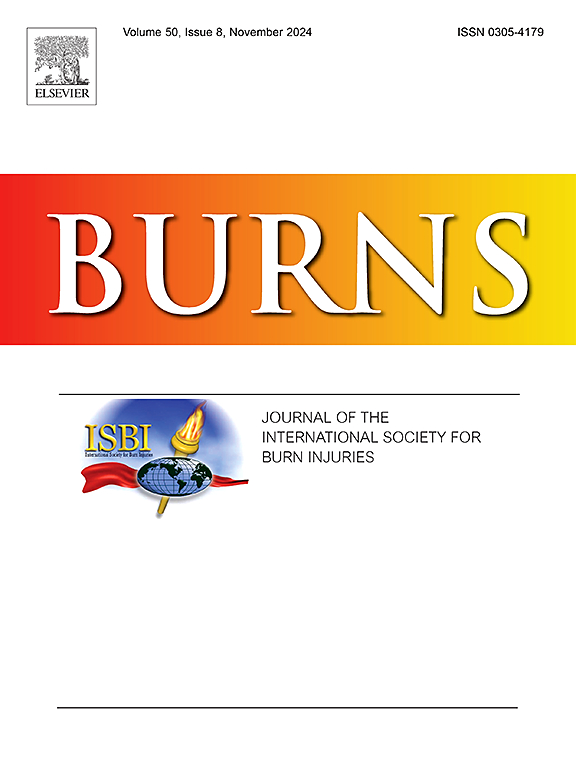Efficacy of an online self-management program for chronic burn pain: A randomized controlled trial of the Take Charge of Burn Pain program
IF 3.2
3区 医学
Q2 CRITICAL CARE MEDICINE
引用次数: 0
Abstract
This randomized controlled trial investigated the effectiveness of an online self-management program, "Take Charge of Burn Pain (TCBP)," for 96 individuals living with chronic burn pain. Participants were randomly assigned to either the 7-week TCBP program integrating cognitive-behavioral therapy techniques, pain education, and self-management strategies or an attention control group focused on general burn recovery information. Assessments conducted at baseline, post-treatment, and 2- and 5-month follow-ups included measures of pain severity, pain interference, pain self-efficacy, posttraumatic stress disorder symptoms, and depression. Compared to the control group, participants in the TCBP program demonstrated greater reductions in pain severity (mean difference: −1.24, 95 % CI: −1.93 to −0.55, p = 0.0007) and pain catastrophizing (mean difference: −5.41, 95 % CI: −10.33 to −0.49, p = 0.0318) post-treatment when adjusting for key variables. At the two-month follow-up, the TCBP group showed significant improvements in pain interference (P = 0.0123), self-efficacy (P = 0.0269), functional abilities (P = 0.0014), and social role participation (P = 0.0498) compared to the control group. Treatment effects were not sustained at 5-month follow-up. Participants in both groups reported high levels of satisfaction with the online intervention, with the majority finding the program helpful and easy to use, and being willing to recommend it to others with pain. Findings suggest preliminary support for short-term benefits of TCBP for managing certain facets of chronic burn pain. This underscores the need to refine digital approaches to maintain and promote long-term improvements. The potential of self-guided online psychological interventions to enhance pain coping strategies for burn survivors persists.
慢性烧伤痛在线自我管理程序的疗效:一项负责烧伤痛程序的随机对照试验。
这项随机对照试验调查了96名慢性烧伤疼痛患者的在线自我管理项目“烧伤疼痛负责(TCBP)”的有效性。参与者被随机分配到包括认知行为治疗技术、疼痛教育和自我管理策略在内的为期7周的TCBP项目中,或者集中于一般烧伤恢复信息的注意控制组中。在基线、治疗后以及2个月和5个月的随访中进行的评估包括疼痛严重程度、疼痛干扰、疼痛自我效能、创伤后应激障碍症状和抑郁的测量。与对照组相比,在调整关键变量时,TCBP项目的参与者在治疗后疼痛严重程度(平均差异:-1.24,95% CI: -1.93至-0.55,p = 0.0007)和疼痛灾难化(平均差异:-5.41,95% CI: -10.33至-0.49,p = 0.0318)方面表现出更大的减轻。在2个月的随访中,与对照组相比,TCBP组在疼痛干扰(P = 0.0123)、自我效能(P = 0.0269)、功能能力(P = 0.0014)和社会角色参与(P = 0.0498)方面均有显著改善。治疗效果在5个月的随访中没有持续。两组参与者都报告了对在线干预的高满意度,大多数人认为该程序有用且易于使用,并愿意将其推荐给其他有疼痛的人。研究结果初步支持TCBP治疗慢性烧伤疼痛某些方面的短期疗效。这凸显了改进数字方法以维持和促进长期改进的必要性。自我指导在线心理干预的潜力,以提高疼痛应对策略烧伤幸存者持续存在。
本文章由计算机程序翻译,如有差异,请以英文原文为准。
求助全文
约1分钟内获得全文
求助全文
来源期刊

Burns
医学-皮肤病学
CiteScore
4.50
自引率
18.50%
发文量
304
审稿时长
72 days
期刊介绍:
Burns aims to foster the exchange of information among all engaged in preventing and treating the effects of burns. The journal focuses on clinical, scientific and social aspects of these injuries and covers the prevention of the injury, the epidemiology of such injuries and all aspects of treatment including development of new techniques and technologies and verification of existing ones. Regular features include clinical and scientific papers, state of the art reviews and descriptions of burn-care in practice.
Topics covered by Burns include: the effects of smoke on man and animals, their tissues and cells; the responses to and treatment of patients and animals with chemical injuries to the skin; the biological and clinical effects of cold injuries; surgical techniques which are, or may be relevant to the treatment of burned patients during the acute or reconstructive phase following injury; well controlled laboratory studies of the effectiveness of anti-microbial agents on infection and new materials on scarring and healing; inflammatory responses to injury, effectiveness of related agents and other compounds used to modify the physiological and cellular responses to the injury; experimental studies of burns and the outcome of burn wound healing; regenerative medicine concerning the skin.
 求助内容:
求助内容: 应助结果提醒方式:
应助结果提醒方式:


